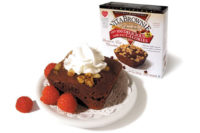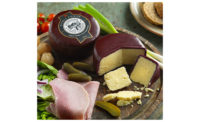Culinary Creations
A Flair for Comfort
When it comes to “comfort foods,” manufacturers strive for authenticity so end-products taste, smell and look homemade.










Comfort on the SideReser’s Fine Foods Inc. has been focusing on side dishes that support those “just like homemade” meals. The company added a line of Main St. Bistro Baked Sides, refrigerated side dishes that use what the company terms a “Top Bake cooking process” to “deliver home-baked taste, right from the microwave.” The company is extending the line into supermarket deli departments, where it will be sold under the Reser’s Baked Sensational Sides brand. For prepared side dishes, such as mashed potatoes and macaroni and cheese, the company developed a baking process that delivers a crispy and cheesy top layer over a rich, creamy base to replicate made-from-scratch casseroles with oven-baked appeal. |
Those old-fashioned comfort foods—pot pies, pot roasts, chicken and stuffing, brownies, mashed potatoes, etc.—carry strong emotional attachments. When approaching the translation of those foods to multi-unit production, reformulation needs to be culinary-driven.
It can be Grandma’s blueberry buckle, an ethnic dish from one’s heritage or a childhood favorite. In any case, it is more than the sum of its parts, and there is little room for error. This means starting with a gold standard for flavors, textures and appearance, from which the developer will industrialize that formula.
At the outset, it’s advised to take a minimalist approach to adding new ingredients, and to ensure chemicals and additives are used only when absolutely necessary. The goal is to make the re-creation as authentic as possible. The ingredients should be as close to what is available in supermarkets, so the end-product is most likely to taste, smell and look homemade.
A Sense of Scale
Perhaps the most difficult aspect of converting a comfort recipe to a commercialized one is a matter of scale, taking that which was designed for a few servings to a few thousand or more. Scaling-up to industrial-sized batches isn’t simply multiplication, although that is where the process starts.
Most likely, the original, small-scale recipe was made in a 4-quart pot or on a stove with direct heat. Moving the scaled-up ingredients into a tilt-skillet or a steam-jacketed kettle doesn’t necessarily result in the same finished product. The wet-to-dry ratio is often the very first challenge. Typically, water levels need to be adjusted, because the production batch is either too thin (most common) or too thick.
If flour was originally used as a thickener, an alternative ingredient might need to be employed. Flour gives many products, especially sauces, that homemade flavor that most starches just can’t mimic. With such a formulation, in attempting to stay as true to the original ingredients as possible, flour alone is generally given a first try. But, sometimes, to ensure a sauce doesn’t break further down the line or in the thaw/cook stage at the consumer’s home, it’s more common to employ both flour and another type of starch. In some cases, formulators need to switch to a non-flour starch completely.
When using flour, the cooking temperature needs to be high enough so that enzymes are denatured. In this case, other ingredients in the product could be affected by the high temperatures or, in turn, affect the starch. Likewise, with most starches, the temperature needs to get high enough to allow the starches to fully swell, so there has to be a sufficient amount of water available to be absorbed by the starch.
The weights and ratios of most of the main solid ingredients, such as vegetables and animal proteins, translate in a fairly straightforward manner, although cooking times will need to be adjusted from the original recipe. It helps in scale-up to use fresh meat and poultry whenever possible, rather than precooked. Once the meat or poultry is cooked, it doesn’t pick up flavors from the surrounding matrix (i.e., sauce or broth). When fresh meat or poultry is cooked with the flavor ingredients, the flavors penetrate into the meat, thereby avoiding a potential disconnect between a flavorful sauce and flavor-devoid protein.
Produce in formulations can be either fresh or frozen. Although other parts of the food industry utilize dehydrated or freeze-dried produce, in a comfort formula it’s important to try to stick with the original, natural version. In scale-up, it’s typically necessary to make adjustments to the water in the formula to compensate for any weep that may come from the fruits or vegetables as they cook.
The Sizzle, Not the Steak
When it comes to spices and seasonings, scale-up gets a little trickier. These ingredients can react quite differently once they are increased. The power of spice and salt can increase geometrically. Herbs, dried or fresh, will take on grassy or bitter notes, while negatively impacting texture and appearance, if simply multiplied according to the scale at which the formula is increased. This is because the flavor of spices and herbs are locked in their volatile oils and released through the cooking process.
Since most home recipes are in small batches, cooked in shorter amounts of time, the flavor-carrying volatile oils do not have time to “open up.” (That’s why items such as spaghetti sauce, soup or chili always taste better the next day, after the seasonings have steeped for 24 hours.)
If the product has a fair amount of oil and butter, it might tend to separate—especially if the cooking time is longer than it was with the small batch. Lecithin, typically derived from soy, is added to many items to bind oil. Sometimes, in order to make a mass-produced item appear more homemade, some formulators might not bind up all of the oil.
At home, oil separation is natural. Using lecithin is an excellent technique, because a product, such as a dairy-based sauce, can be specifically designed so that just a fraction of the oil separates out, while most is bound, helping to achieve that homemade appearance. Developers may present several variations to a customer and let them decide.
Addressing a previously high-fat, creamy, dairy-based sauce in smaller batches, from a large pot on the stovetop to scaling-up and switching to a steam-jacketed kettle in production, can raise technical problems—specifically, oil separation on a grand scale. Simply ramping up lecithin won’t affect the oil.
The knowledge that the lecithin molecule conforms into a barbell shape, with one end securing oil and the other securing any water-based substance, allows for a surprising fix. Adding water allows the lecithin to better incorporate the oil and achieve a smooth batch sauce.
A number of dry dairy ingredients and blends are available for food manufacturers in different parts of the food industry. With a little TLC, fresh dairy can often be used. Cheese, however, can pose problems. To get the cheese flavor strong enough to be noticed, the amount of natural cheese needed can engender failure from a functional standpoint, resulting in a product that turns stringy or greasy. Combining highly concentrated, natural cheese flavors with smaller levels of dairy cheese can maintain comforting cheese flavor in a texturally sound product.
Special Considerations
Grandma’s foods just tasted good—they made the mouth happy. But, marketing Grandma is not an issue; marketing a mass-produced version of her recipes is. In addition to flavor and appearance, the food needs to conform not only to authenticity, but to the attractive trends of today; healthfulness is a primary trend.
Manufacturers must continue to develop foods with flavors strong and at the forefront, and the lack of salt and fat must be less apparent. Some easy fixes for lowering sodium have been to increase spices and herbs, or to try different spices in traditional foods to compensate.
For example, in order to meet customer needs, PepsiCo was looking for ways to reduce sodium in its Frito-Lay brand of chips without losing that satisfying, salty flavor. According to Carlos Barroso, R&D executive for Pepsi, the company was especially active in researching new formulation technologies for creating micro- and nano-sized particles. This includes suspending those particles for delivery and application, as well as employing new drying techniques for halide salts, in general.
In conjunction with NineSigma Inc., an open-innovation service provider, Barroso notes Pepsi was able to identify a new approach for continuous production of halide nano-particles and provide a commercial partner able to dip/coat the particle surfaces. They were able to create a “crystal salt” by reducing the surface area of salt, allowing formulators to reduce sodium levels while still retaining a salty punch. The integration of the new salt formulation into Pepsi’s snack food products has been developed and is available in the market.
Sweet Comfort
Remember Grandma’s blueberry buckle? Blueberries have been spearheading a return to comfort in the sweet category almost as much as chocolate. According to Tom Payne, the industry specialist for the U.S. Highbush Blueberry Council, this is due to the versatility, availability and sheer quantity of blueberry formats that have turned blueberries into a choice ingredient for chefs, food development and processors.
“Dehydrated blueberries, diced or whole, are ideal in mixes and other dried products, bringing out a sweet richness to baked goods, while their blue color is often an added plus for special interest and unusual appeal,” says Payne. Freeze-dried products can be used to provide crisp flavor notes, tang and authentic fruit-flavor bursts. For baking formulations, individually quick-frozen blueberries can be used straight from the package without thawing.
“In fact,” says Payne, “adding blueberries while still frozen will result in less breakage. Frozen blueberries can be folded into batters.”
The low-pH range of blueberry juice and blueberry purée provides tangy flavor and helps improve storage stability. Fillings with substantial amounts of blueberry offer special eye appeal. Powders may be used as a coating, such as in chocolate confectionery, or in cereals and bars.
“Blueberry juice and blueberry purée also provide luscious color, smooth texture and distinctive flavor,” adds Payne. Available year-round, blueberry juice and blueberry purée are excellent choices in new and existing food product formulations.
In baking, versatile blueberry formats, such as osmotically preserved blueberries, allow bakers to use the ingredient in a variety of ways, while blueberry powders work well in items such as rice cakes and bar cookies.
Whether sweet or savory, the merging of comfort, convenience and healthful goodness has strong potential for continued growth, as daily stresses push people toward soothing themselves with good food that is evocative of childhood. With each generation growing up further removed from the kitchen, the foods processors create to fill that gap are likely to occupy an even greater position at the head of the family table. The next generation of comfort cuisine is as likely to evoke what grandma used to heat, as well as what she used to bake. But, as long as the ingredients, flavors and aromas are authentic, that’s OK.
Looking for a reprint of this article?
From high-res PDFs to custom plaques, order your copy today!






